Text
Motifs
Abstract motifs
Lines only
Koshi: vertical trellis
Tasuki: diagonal trellis
Kagome: basket design
Higaku: cypress fencing
Complex combos
Rai: lightning
Kikko: tortoise shell
Manji: joined swastika
Circular designs
Yo-mon
Representing constellations
Shichiyomon = 7
Kuyomon = 9
Been around at least since Nara Period
Figurative Motifs
Flowers were very popular and connected to femininity
Most common blossoms (all have lots of poetic connotations)…
Plum
Cherry
Wisteria
Bush clover
Hydrangea increased in popularity during Azuchi-Momoyama Period and Edo Period
Lotus are avoided due to religious connotations
Chrysanthemum, iris, lily, and autumn grasses were also popular, but needed novelty to be considered interesting
More nature…
Tree trunks
Leaves
Pine
bamboo/sasa
Willow
Vines (popular with courtesans)
Confusion virtues that liked to be used
“Three companions”
Pine
Bamboo
Plum
“Four gentleman”
Plum
Chrysanthemum
Ran orchid
Bamboo
Animals
Phoenixes
Cranes
Roosters
Mandarin duck
Muromachi Period introduced…
Herons
Cormorants
Sparrows
Swallows
Quails
Edo Period introduced (for women as well)…
Hawks
Eagles
Birds of prey
Other live things
Butterflies
Dragonflies
Hares
Items
Cartwheels
Fans
Poem squares/rectangles
Boxes
Instruments
Water motifs
Bamboo basket work
Drying nets
Boats
Bridges
Flowing water
Waves
Waterfalls
Places
Farmhouses
Pavilions
Wattle and brushwood fences
More nature stuff
Clouds
Mist
Snow
Yukina “snowflake”
Uta-e/ashide-e
The blending of japanese characters into nature scenery
#kimono#kimonos#historical#historical fashion#japanese historical fashion#japanese designs#motifs#textiles#research#research notes#fashion
0 notes
Text
Techniques
Types of Techniques: Wow I Wish I Had the Means To Do Any of These
Gold Foils
Surihaku
“Printed foil” or “impressed foil”
Originated in the Nara Period
How: paste is applied to fabric (shusu or rinzu satin) over a stencil. The stencil is removed and while the paste is still wet the foil is applied. Any extra is brushed away
Cloth used is usually a deep red, purple, or indigo
Rose to popularity in Muromachi period due to imports
Not many extant garments, as the foil by this time has flaked away
Used often for Noh costumes
Nuihaku
Combo of surihaku and embroidery
Done to give the designs more depth

Photo Source
second half of the 18th–first half of the 19th century
Embroidered silk satin
Egret and Willow Tree The Met Museum
Tsujigahana
Combo of tie-dye, hand-painting, and surihaku
Came about during Muromachi to Azuchi-Momoyama Period in Kyoto

Photo Source
late Momoyama period
Plain-weave silk with resist dyeing and ink painting
Horizontal Stripes, Flowering Plants, Fans, Snowflakes, Clouds, and Bellflowers The Met Museum
Woven Designs
Aya
Twill
Rinzu
Figured satin
Nishiki
Weft and weave threads are different colors
Kinran/Ginran
Gold/silver threads used in weft/weave
Tsuzure-ori
Tapestry weave
Ukimon-ori
“Floating-design weave”
Long lengths of thread are “floated” on the surface of the fabric
Can still be seen in obi designs
Noshime
Striped fabric weave

Photo Source
Meiji Period
Noshime Furisode with Dragons and Clouds in Cloud-Silhouette Band on Dark Brow
Kyoto National Museum
Dyeing and Printing
Kokechi
“Tie-dyeing”
Shibori
A type of non-wax resist dyeing
Fabric is wound with cord and dyed in indigo
Nuishime-shibori
Fabric is sewn together and then dyed
Created during the Muromachi Period
Nui-shibori
Combo of shibori and embroidery
Murago
Different shades of the same color merge into each other
Rokechi
Wax-resist dyeing
Kyokechi
Block-resist dyeing
Kata-zome
Combo of stencil dyeing and block printing
Used during the Nara Period
Gave way to “Komon” (small pattern)
Yuzen-zome
Created by Miyazaki Yuzensai (Kyoto Yuzen)
How: a design is painted on the cloth with paint and dyestuffs, fixed with a liquor made of beans, and sealed with a paste made of rice before the surrounding area is dyed.
At the same time Miyazaki was working in Kyoto, this technique was also being discovered at the same time in Kanazawa in Kaga Province
Kaya yuzen
Bright colors
Considered more charming
Kyoto yuzen
Darker colors
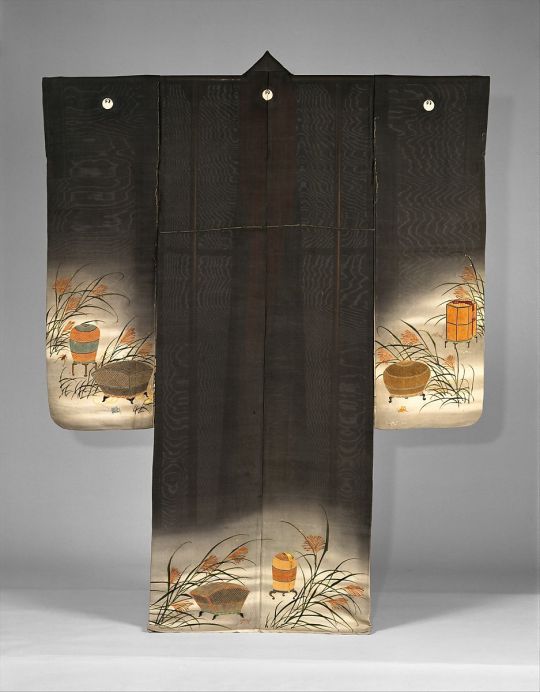
Photo Source
Early Meiji period
Paste-resist dyed (yūzen) and painted silk gauze with embroidery
Unlined Summer Kimono (Hito-e) with Crickets, Grasshoppers, Cricket Cages, and Pampas Grass The Met Museum
Kirihame
Applique and patchwork
[on the topic of Japanese color culture]
“The same preference for gradual change is the reason a shade of grey called usu-nibi-iro was worn for morning rather than black. It represented not a sudden descent into the dark of night, but a gradual transition into twilight.” P.161
Part 5
#kimono#kimonos#historical#historical fashion#japanese historical fashion#japanese designs#japan#research#research notes#textiles#dyeing#fashion
6 notes
·
View notes
Text
Design
Yabo vs Iki: Old vs New
During the Edo period two opposing fashion styles appeared.
Yabo
Creatively weak
Repetition + reduplication
Often times too much was going on (very busy patterns)
Pushed by the court
Iki
“chic”
A response to yabo
“Pure, unadulterated”
A big focus on simplicity
Was essentially a fashion rebellion
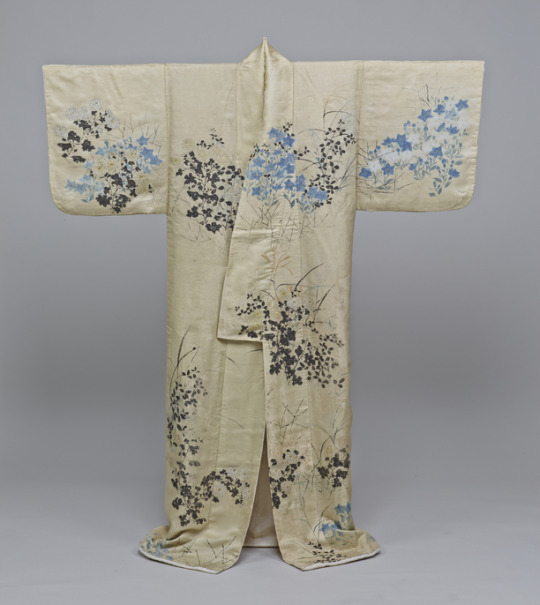
Photo Source
Edo Period
Autumn grass design on white twill ground Hand-painted by Ogata Korin
Tokyo National Museum
Side Note
Bright colors at one point had been banned, so people took to wearing bright colored under robes. Rules will never contain fashion
Designers: The Forgotten Group
Kimono designers at the time were highly neglected, and we don’t know many of the designer’s names or who they were!
A possibility is that they were painters patronized by the shogunate. Official painters would paint in the traditional sense, but they also designed furniture and buildings, so there’s a strong possibility they also created designs for clothing.
Screens of the time closely resemble kimono designs in talent and subject matter
We do know that drapery merchants soon began training in design to keep up with public demand, but names are hard to find.
Types of Designs
Katami-gawari
“Half the body different”
The right and left sides of the garment are made of different fabric
Seen in a lot of Noh costumes
This design has been around for a long time (at latest 14th century) as a cost-saving method
Nobles picked it up during the Azuchi-Momoyama period
There’s also a horizontal version
Dan-gawari = chessboard version
“Stepwise different”
Purely for the aesthetic

Photo Source
Azuchi-Momoyama - Edo period, 16th-17th century
Nuihaku Garment Clematis scroll, pampas grass and fan design on black and brown ground
Tokyo National Museum

Photo Source
first half of the 19th century
Twill-weave silk brocade
Noh Robe (Atsuita) with Young Pines, Cherry Blossoms, and Dandelions The Met Museum
Kato-suso
“Shoulders and hem”
Designs are placed only around the shoulders and hem, which is usually done in embroidery
Somewake Keicho
Thought to date around the Muromachi to Azuchi-Momoyama Period
The fabric is cut in circles, rectangles, and triangles arranged and sewn next to each other
The beauty comes from the shapes fitting perfectly together
Large Designs
Popular in 1660, partly because people liked having a large design and partly as rebellion against the feudal system
Family crests were a popular large design
Chirashi-moyo
“Scattered motif design”
Seen as far back as the Nara Period
Scattered characters were very popular along with scattered fans (“semmen-chirashi”) and family crests
Stripes and Checks
Not super popular until much later because of how easy it is to make the fabric
Became popular in the Muromachi Period party because of imported fabrics from China and Europe having striped and checkered patterns (“kanto”)
Kanto was used a lot for tea ceremonies
Noh costumes also really pushed this along
Pictorial Designs
A characteristic feature of Japanese textiles.
Popular in the Heian period
Yuzen-zome (dyeing technique) helped push it along
Part 4
#kimono#kimonos#historical#historical fashion#japanese historical fashion#japanese designs#clothing#research#research notes
18 notes
·
View notes
Text
Noh Theater--Costumes Directly Affect Fashion
Noh plays: A form of theater that focuses on tragic, dramatic stories set in a time “long, long ago” (usually past courts). The actors wear masks that represent the character they are playing. A focus on “bringing the spirits back to tell their tale.”
Kyogen plays: comedic interludes between Noh plays. A focus on familiarity and relatability. Used to be totally improved.
“If the kosode suggests the warmth of the person wearing it, Noh costumes suggest a cool, spiritual quality. It has a strange kind of colorfulness.” -p.53
A Brief History Of Noh Theater; For Context
The form reached maturity when actor/playwrights Kannami Kiyotsugu and his son Zeami Motokiyo were “discovered” in 1374.
Noh had existed before that (probably for around ~200 years) but had little to no funding behind it. It mostly consisted of traveling troupes performing for what they could.
Noh theater came under the patronage of the shogun when samurais were still trying to separate themselves from the court they had just taken over. They wanted to replace the traditional style of dance that had been used for court celebrations, and Noh theater appeared at just the right moment. Thus, they put a lot of funding into the theater and it quickly became a “sophisticated art form” only for the middle-upper class and those lucky enough to find their way in.
Noh’s Costumes Quick Development
At first, Noh costumes were the shogun household’s old clothing, as the topic often focused upon in Noh plays is tragic court stories and thus the actors needed nice clothing to represent that, all the better if the clothing was slightly older. Soon, the theater would have enough money to begin creating their own costumes. However...
“There was a custom at that time of rewarding a retainer [actor] by taking off an item of clothing and presenting it to him. As early as the Heian Period, rewards for distinguished service took the form of bolts of cloth, but occasionally a garment that happened to be worn at the time would be presented instead. The recipient would then drape the garment about his shoulders and make his exit. In the case of a dancer, the recipient would perform an encore with the gift in his hands.” -p.54
Clothes gifted would be used in later performances.
This created a culture of competition between Noh theater troupes, as they felt the costumes used reflected their troupe’s talent.
A Fun Side Note: Types of Noh and Kyogen Costumes
Female Costumes
Karaori
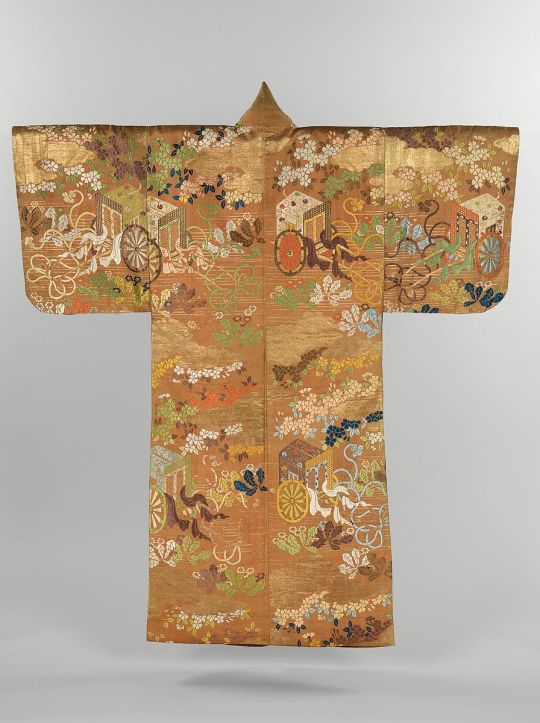
Photo Source
late 18th–first half of the19th century
Twill-weave silk brocade with supplementary-weft patterning in metallic thread
Courtly ox carriages, dandelions, and cherry blossoms partially covered by the opaque gold clouds typical of Genji paintings. The Met Museum
“Chinese Weave;” named because the garment was made of a heavy, elaborate patterned fabric from China
Because it was originally a Chinese import, this suggests these were first gifts from ladies of the shogun’s household, as the troupe wouldn’t have the funds themselves at the time.
Eventually came to mean costumes made in Japan after the fashion of the original ‘Karaori’
Karaori would become the outer robe and continue to be made of heavy fabric
Karaori with red in the design
Represents a young woman
Karaori with no red in the design
Represents an older woman
Surihaku and Nuihaku
Sometimes worn under a karaori

Photo Source
Edo period
Surihaku No Costume with Gold Leaf Fish Scale Diaper on Salmon Pink Satin Ground
Kyoto National Museum
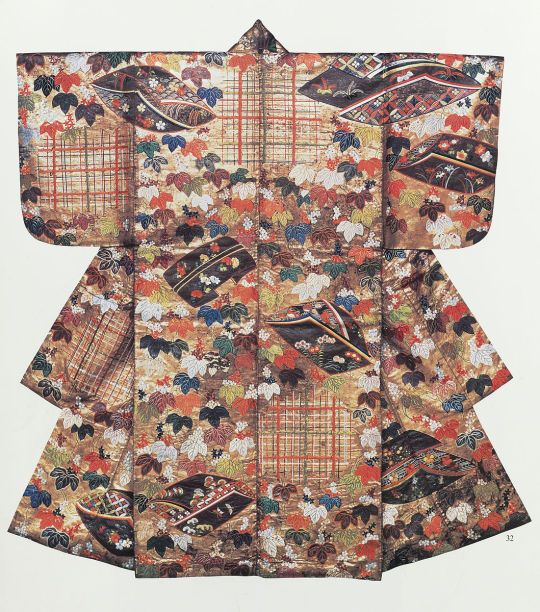
Photo Source
first half of the 18th century
Silk embroidery and gold leaf on silk satin
The Met Museum
Maiginu
“Dance robe”

Photo Source
Edo Period
Maiginu Garment Noh Costume Hydrangea and cloud design on purple ground
Tokyo national museum
Male roles
Atsuita
Resembles the Karaori
Made of heavy brocade with designs in colored, gold, and/or silver yarns
Used for demon roles when worn under…
Mizugoromo
Happi
Sabutsugi
Choken

Photo Source
Edo period
Noh Costume Design of stylized tortoiseshells, interlocking circles, and paulownias on a yellowish green, brown and light blue checkered ground
Tokyo National Museum
Atsuita-Karaori
Even more closely resembles karaori
Kariginu
Lined
Represents deities and men of high rank
Unlined
Shinto priests

Photo Source
Edo Period
Paulownias and square-shaped crests on dark blue ground
Tokyo National Museum

Photo Source
Edo Period
Bamboo design on white ground
Tokyo National Museum
Choken
Resembles the maiginu
Represents feminate natured males such as ‘young nobleman’
Sometimes used instead of maiginu
Usually festive and colorful
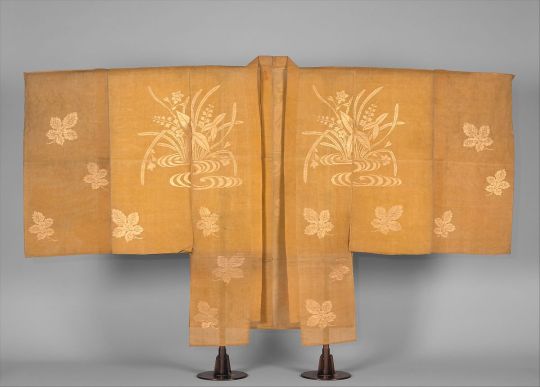
Photo Source
Edo Period
Silk gauze (ro) brocaded with metallic thread
Scattered mulberry leaves decorate the base of the robe and sleeves, while larger, crestlike compositions of water plants decorate the chest and shoulders. The Met Museum
Happi or Ho
Lined
Represents demons, gods, or generals
Unlined
Battle attire of a young noble
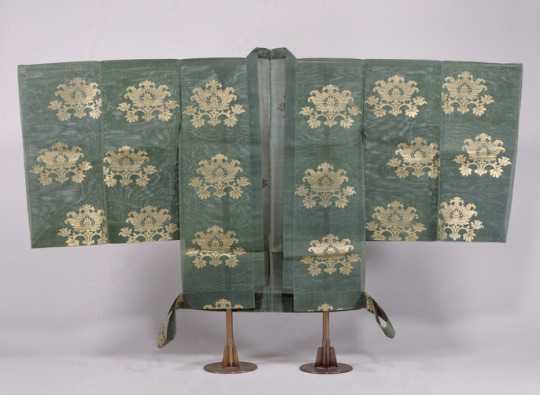
Photo Source
Edo Period
Karahana floral design on green ground
Tokyo National Museum
Sobatsugi
Essentially just a lined happi with the sleeves removed
Represents armor
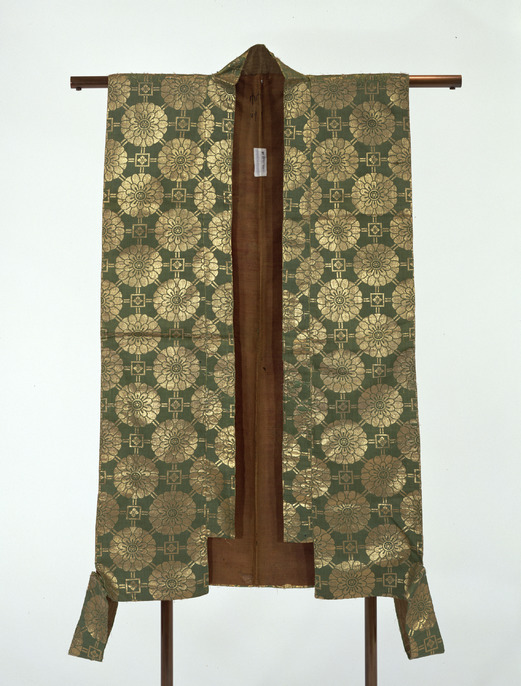
Photo Source
Edo Period
Interlocked chrysanthemum design on light green ground
Tokyo National Museum
Noshime
Plain
Represents ‘old-man’ and buddist priest roles
Banded
Represents common folk and low-rank samurai
Sometimes used to represent low-born women

Photo Source
Edo Period
Design of check pattern with bellflower crests on green
Tokyo National Museum
Suo
An unlined garment of hemp fiber
Basically a simplified hitatare
Represents everyday wear of samurai and common people
Hangiri
Form of hakama (aka trousers)
Usually has a rich, woven design
Worn with happi
The motifs used in the design would also give clues as to the type of character, such as...
Grasses and flowers = femininity
Poetry (aka books or actually poems) = a court lady
Lions, clouds, lightning = strength
Kyogen Costumes
Kyogen uses more natural speech and movements, and some types of characters don’t wear masks. It was meant to be familiar to the audience and was more contemporary in nature when compared to Noh.
Visit here to see a full ensemble of a kyogen costume
“...Kyogen performances were improved, using whatever garments happened to be on hand.” -p.66
Kyogen has three common characters
Country bumpkin
The simpleton
The servant/head-servant (tarokaja)
The country bumpkin/simpleton would oftentimes wear…
Robe garment decorated with gourds and trivets
The servant would wear…
Patterned katagiri of hemp over striped noshima
Hakama trousers decorated with family crests
The master (when included) would wear…
Vestlike garment resembling a katagiri and long trailing kakama over banded noshima
It was common for people to incorporate design aspects they had seen in a Noh costume into their daily wear. Thus the people continually called for more beautiful costumes, both for inspiration and for a deeper theater experience, and the theater responded in kind. A kind of cycle was born. This cycle has been around since Noh theaters spike in popularity, but became especially important during the Edo period, where the theater was one of the only places fashion could continue to be explored freely.
Part 3
#kimono#kimonos#noh theater#noh theater costumes#costumes#theater#japanese theatre#historical fashion#japanese historical fashion
9 notes
·
View notes
Text
The Kimono and It’s Development
“To think of clothes only in terms of efficiency is to disregard the human element. If people have to work, they also have to play.” - P.12
Causes of Early Development
Climate
As an island nation, Japan suffers from extremely hot and humid summers, thus the need for something that wouldn’t cause heat exhaustion was dearly needed
Constructing wooden-framed buildings
This is linked to the Japanese tradition of sitting on the floor, which arose a need for something that is easy to sit on the floor in.
Side Note!
There is evidence that in early Japanese times, there was a period where it was common for everyone to wear dress consisting of separate upper and lower garments like in the West.
Early Influences: The Chinese Hanfu and Juni-Hitoe
China’s T’ang Dynasty (618-907) had a big influence on Japan in terms of fashion during the Japanese Nara Period (710-784)
Japan really liked the Chinese ‘Hanfu’ and used that style of dress. Japanese nobility grew out of the style slightly around the 10th century during the Heian Period, but the commoner class would continue to dress in a ‘Hanfu’ like garment until the Kamakura Period (1192-1333)
Interestingly enough, the hanfu is making a come back in current Chinese fashion
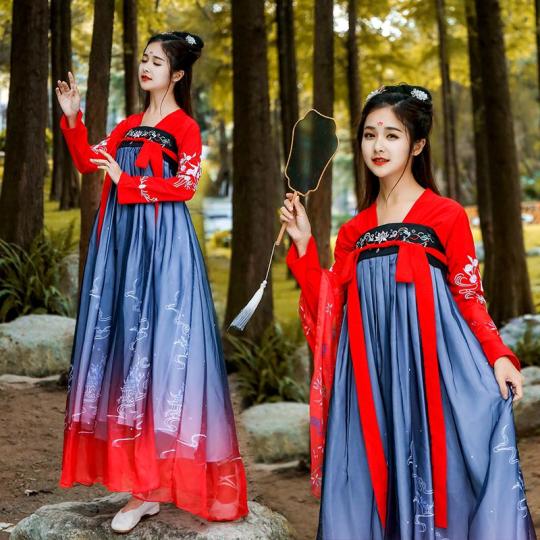
Roughly what a hanfu would look like. Photo pulled from here. If anyone knows of any museums with public photos of extant hanfu please message me so I can change this picture.
The Heian Period brought about the style of ‘Juni-Hitoe’ (“twelve robes”) which only high ranking noble women wore for specific occasions. This style, though only worn by a small number of people, and only during certain occasions, is essential to the development of the kimono, as we shall see later.
[talking about the robes used] “Each one was simple in color and design, but the aim was the complex beauty at the collar and sleeve openings, where the color of all twelve robes were visible.” -P. 25

Photo pulled from here.
Kamakura Period: Politics enters the world of fashion (unsurprisingly)
The Kamakura Period marked a big political change for Japan. The Taira Family, which had been running the court system of Japan, had been taken over by the samurai class, marking the end of the Heian Period. The samurai, now in charge of the nation, were looking to separate themselves from what had come before. They wanted to create their own culture.
Kamakura Period women, looking to separate themselves from the previous Heian noblewomen, slowly changed from wearing multilayers (“kasame-gi”) to a single layer (“hitoe-gi”).
Enter the Kosode
The Kosode was originally the undergarment robe worn when a lady wore the Juni-Hitoe style. Now that women were only wearing one robe, the kosode transitioned from an undergarment to an outer garment.
“Kosode is an old name for the form of dress that is now usually simply called kimono.” - P.13
A Necessary Side Note: Characterizing Kimono Types
I find it easiest to think of kimono as an umbrella term, because kimono have different names depending on the type of sleeve it has and/or the type of material it is made of and/or the occasion it would be worn on. This is important to note when looking at extant garments to understand who would have worn it, when, and why. The different types of kimono covered in this book are…
Kosode (“small sleeves”)
Oftentimes sleeves are totally sewn shut; looking to the picture we see there is no gap between the torso section and the sleeves. Also we see that the sleeves are a bit short.
Ended up being associated with the lower class for a while

Photo Source
Second half of the Edo Period
Silk and metallic thread embroidery with resist dyeing on satin damask
Cherry blossoms, a fence, and carriage wheels The Met
Hirosode (“wide sleeves”)
Wide as in arm to floor length
Sleeve end left open
Worn by the upper class for a while
Osode (“large sleeves”)
Large as in shoulder to wrist length
Furisode (“swinging sleeves”)
Only a quarter of the sleeve is open
Considered a special type of kosode

Photo Source 1912-1926 Silk crepe; freehand paste-resist dyed, embroidered in silk and metallic threads with applied gold and silver Boat filled with flowers on swirling water, pine tree, plum blossoms and maples The Khalili Collection
By this point (end of the Kamakura Period, beginning of the 13th century) we essentially have today’s kimono. This garment will not be seeing any more physical alterations. However, the kimono will go through many design/patterning/technique shifts from this point forward. The book continues to refer to kosode specifically, so I shall as well.
“Again, however unique it may be, unless it is also aesthetically pleasing, it is not worth the nation’s pride.” - P.10
Azuchi-Momoyama Period: When Color Filled the Streets
Up until this point (~1300 all the way to ~1573) the kosode would remain frugal and simple so as to adhere to the samurai way of life until…
The period of 1573-1603 (Azuchi-Momoyama Period) had a strong focus on abandoning the old and letting in the new after years of warfare. Class was ignored and creative freedom reigned. There was a large focus on personal freedom.
Men began exploring more color and design in their clothing

Photo Source
Late Azuchi-Momoyama Period
Plain weave with un-glossed warps and glossed wefts silk
Paulownia leaves and arrows
Dofuku worn by Toyotomi Hideyoshi
Kyoto National Muesum
Better pictures here.
Red light districts and theaters went crazy with their fashion during this period
“Prostitution was a way of keeping alive for women who found themselves in reduced circumstances as a result of the wars… the women wore kosode of striking design. Most of the kosode of that period left today are garments once worn by members of wealthy families; no example of kosode used by courtesans is extant. Perhaps such garments were used until they were completely worn out.” - p.32
Sadly this period only lasted from 1573-1603 and then…
Edo Period: The Lame People Take Over
During this period the shogunate emphasized people acting within their class status. There were many new rules created desperately trying to regulate fashion. However, as many rules as they made, rules can never stop the creative flow of fashion.
There would actually be a shift away from the kosode to focus on the obi and what a person could do with it creatively.
The licensed district (approved red light districts) and theaters became hot spots of fashion.
“The fact that the licensed quarters acted as a hothouse for the development of the impractical hairstyles of the time, with their ornamental combs and hairpins, is an indication of how eagerly personal adornment was pursued in the island of freedom.” -p.39
It was during this period that the theater truly began to change the fashion world…
Part 2
#kimono#historical fashion#japanese historical fashion#fashion#research#research notes#historical#japan#kimonos#kosode
16 notes
·
View notes
Text
Japanese Costume and Textile Art by Seiroku Noma
Japanese Costume and Textile Art by Seiroku Noma
Copyright 1974
Table of Contents
The Kimono And It’s Development
Noh theater--Costumes Directly Affect Fashion
Designs
Techniques
Motifs
Extant garment photos found at…
The Met
The Khalili Collection
ColBase database (database of photos from National Museums around Japan)
The National Treasures & Important Cultural Properties of National Institutes for Cultural Heritage, Japan e-museum doesn’t have any public domain photos, so I suggest you actually go to their website to look really cool pictures
#kimono#historical#historical fashion#research#research notes#garments#japanese historical fashion#kimonos#kosode#noh#noh theater
2 notes
·
View notes